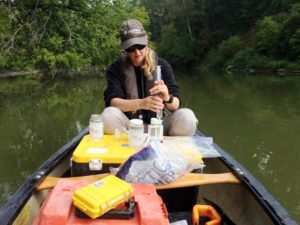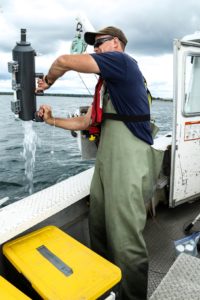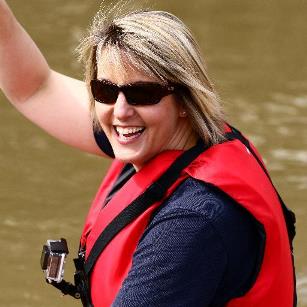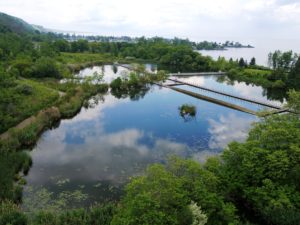Not long ago, Barry Laverick was invited to his daughter’s fourth grade class in Markham, Ontario, Canada to talk about water.
The students at Roy H. Crosby Elementary School were studying the Great Lakes and Laverick, Project Manager of Water and Waste Water Projects in the Region of Durham, was keen to share his knowledge with this group of young minds.
Laverick began his talk by asking the children a simple question – “how many of you have actually touched Lake Ontario?” When only a few hands went up, he asked the students to fill a pitcher with water from the drinking fountain. Moments later, he asked each of them to reach in and touch the water. The students were puzzled but did as instructed. When every child had taken their turn, Laverick paused and said with a grin, “Guess what? You just touched Lake Ontario water.”

Water management in the Toronto region is highly complex. Nine rivers flow down from far north of the city to Lake Ontario. Ensuring clean, safe water for the 5,000,000+ people in this ever-changing landscape involves many partners working together.
In the Greater Toronto Area (GTA), the connection we share to our largest source of water is often difficult to fathom. Those young students in Markham were surprised to learn the bulk of their drinking water comes from Lake Ontario – a body of water more than 20 miles away. They’re not alone. Few living north of Finch Avenue would make the connection that the water they use comes from the 14th largest lake in the world.
Like other cities situated on the shores of a Great Lake, Toronto faces numerous challenges when dealing with its water. The strain of an urban centre, the crush of a constantly growing population and the struggle to keep pace repairing or replacing infrastructure, has led to a greater need for a collaborative approach to managing water in the GTA.
Nine rivers originate far north of the city and wind their way down to Lake Ontario. Toronto and Region Conservation, (TRCA), with its partners, works to ensure our water is clean, healthy and safe and that Lake Ontario water is drinkable, fishable and swimmable. From monitoring water quality in our tributaries and in the nearshore, to identifying threats to our lake intakes and growing trends for fish and wildlife, the message is clear.
Our water system is a seemingly bottomless well filled with issues to address. And while many would argue water management is more complex than in years past, those who’ve worked in the field for the bulk of their professional lives know better.
“We’re involved in every aspect of the water cycle,” Brian Denney, CEO, TRCA, said. “It’s been that way since the creation of the 36 conservation authorities here in Ontario. We study water on a watershed scale, not just surface, but ground water and the hazards of flood- prone areas, and we understand that many other factors come into play in an urban setting. The water cycle context is what we’re called on to deal with every day. But now, it’s now being impacted by threats we can barely even guess at.”
 Denney points to climate change as a significant marker on the horizon for anyone who manages water quality and quantity. He says the impact of more frequent and severe storms is already being felt and our flexibility to evolve will be mandatory in the years to come.
Denney points to climate change as a significant marker on the horizon for anyone who manages water quality and quantity. He says the impact of more frequent and severe storms is already being felt and our flexibility to evolve will be mandatory in the years to come.
Not all water management requires high tech solutions. Some of the most successful efforts to improve water quality and quantity are rooted in the past – namely wetlands. Gord MacPherson, Associate Director, Restoration Services, TRCA, says his much of work entails recreating what existed previously to protect against climate change now and in the future.
“More than 90 per cent of the wetlands that existed were removed by the first settlers,” McPherson said. “The engineering of wetlands is brilliant and our work restores them to improve water quality. In 10 years, we’ve created 823 hectares of greenspace and that’s something we’re proud of. As more severe storms head our way, it’s wetlands and the restoration of natural shorelines that will protect against flooding and erosion.”
That ability to move with the times, led by science and new technologies, is the cornerstone of the progress made to date. Back in 1959, a few years after the devastation of Hurricane Hazel, conservation authorities created flood management plans. The thinking then was that this preferred approach to dealing with water – through a system of 14 regional dams and reservoirs would protect both property and people. Over time, a re-think was needed because of the cost and risks involved. Too many people lived below the dams and were in jeopardy if a dam was breached, and reservoirs simply weren’t large enough.
In the 1960’s and 70’s, the municipalities of York and Durham, with the help of the Ministry of the Environment, began to disconnect sewage treatment plants from river systems used previously. Larger, more efficient plants situated on Lake Ontario took their place. The larger dilution rate of the lake was a vast improvement to that found in rivers and yet another advancement in water management took shape.
Stormwater management took a giant leap forward in the 1970’s and 80’s with the creation of retention ponds. TRCA was a leader in the construction of these ponds which gave neighborhoods across the GTA far greater flood protection and later became community assets, giving residents access to nature trails and providing habitats for various species.
In the last decade, another shift emerged. This one utilized the will of both businesses and the public by showing the connection of runoff into storm drains and ultimately, into Lake Ontario. Low Impact Development, (LID), changed the way we looked at water management, moving it off the shoulders of municipalities and agencies like TRCA, to a more collective approach.
 Now, business and residents alike starting taking stormwater seriously and a conscious switch to initiatives like permeable pavement, rain gardens and rain barrels began in earnest. The idea of ‘harvesting the rain’ to feed the groundwater source had come of age. Along with the growth of green building, this newest trend shows signs of aiding in the adaptation to climate change.
Now, business and residents alike starting taking stormwater seriously and a conscious switch to initiatives like permeable pavement, rain gardens and rain barrels began in earnest. The idea of ‘harvesting the rain’ to feed the groundwater source had come of age. Along with the growth of green building, this newest trend shows signs of aiding in the adaptation to climate change.
“There’s no silver bullet for managing water in a city region the size of Toronto,” Denney said. “It’s about transforming the way we do what we do if we hope to stand a chance in the future. What’s taking place now is heartening, but it’s not happening as fast as climate change is advancing. We must do more.”
Probably the biggest hurdle to overcome in improving Lake Ontario water is the prevailing lack of understanding of how land use affects it. Despite vast improvements in many areas, this absent “land to lake” connection is one of the reasons why more work is still needed and why the Toronto Region remains one of 43 Areas of Concern on the Great Lakes. The draining of runoff from centuries of agriculture, industrialization and urban development into our rivers and subsequently Lake Ontario, have taken their toll.
The news isn’t all bad. Since being identified in 1987, a substantial number of improvements have brought the region closer to being delisted. The collaboration of conservation authorities—the Ministry of the Environment and Climate Change, Aquatic Habitats Toronto, etc.—as part of the Remedial Action Plan (RAP), resulted in a reduction of E. coli. Now eight out of 11 Toronto beaches are Blue Flag beaches – the highest standard awarded.
Levels of contaminants in fish have declined to the point that consumption restrictions have been lifted on many species. Watershed health is improving and phosphorus levels are decreasing.
TRCA and other agencies are working together for a common goal. The Source Water Protection team collects data that informs long term policies to make our drinking water sources safe, including 11 intakes on Lake Ontario in Toronto. Threats include tritium from nuclear power plants, sewage, pipelines and fuel storage tanks.
“Our work is about protecting the source of our water long before it gets to the tap,” says Jennifer Stephens, Manager, Source Water Protection at TRCA. “Lake Ontario isn’t one of the sources of water in our region – it’s the only source and there’s a lot at stake.”
 Programs working in tandem have been ongoing for some time, including nearshore water quality monitoring from the Rouge to the Carruthers watersheds. In place for more than a decade, this program can be used as baseline data with changing climate patterns like of high precipitation or periods of drought.
Programs working in tandem have been ongoing for some time, including nearshore water quality monitoring from the Rouge to the Carruthers watersheds. In place for more than a decade, this program can be used as baseline data with changing climate patterns like of high precipitation or periods of drought.
Krista Chomicki, Watershed Specialist at TRCA, says understanding the land to lake connection is key: “We use science to study the impacts being made and the changes needed. The way we use land does have an effect on our water and we need to be conscious of that. This holistic approach makes a difference.”
Chomicki is also involved in a tributary monitoring program, a bi-national initiative that examines the water draining into the Great Lakes and the impact on water quality. Scientists from Canada and the U.S. study the lakes on a rotating basis, looking at biology, chemistry and physics, monitoring and modelling the data collected.
TRCA contributes to this work by coordinating the efforts and setting up sampling stations that produce the data to calculate the nutrient loading of phosphorus, nitrogen and suspended solids into Lake Ontario in Toronto. Information like this is being used to determine action steps to resolve harmful algae blooms in Lake Erie and has the potential to inform us on conditions supporting nuisance algae along the shores of Lake Ontario.
TRCA and the Credit Valley Conservation Authority are exploring the creation of a Western Lake Ontario initiative engaging municipalities, regions, agencies and community groups in the basin from Niagara to Coburg. The group would be funded by the federal Ministry of the Environment with the support of its provincial counterpart and will look at solving today’s water issues collectively.
It’s trying to solve today’s water challenges that keeps Scott Jarvie’s TRCA Environmental Monitoring team in constant demand. By studying the existence or lack of specific fish and bugs in the rivers and streams of the Toronto Region, educated guesses are made on the health of the watersheds and the water itself. He calls it the “canary in the coalmine” theory, referring to the impacts denser urbanization, contaminants and habitat loss are having on the environment.
Jarvie says the concern coming from the data his team is collecting is real. “Water here in our region is changing. The stress of urbanization is changing the flows, quality and biotic communities living in them,” Jarvie explains. “We call it ‘urban stream syndrome’, and it’s showing a direct connection that growth is having here. The water is under stress and our data helps to support the work to relieve it. Ten to 12 years ago, chloride (road salt) wasn’t an issue but it’s making its presence known now.”
Water management in Toronto is like a puzzle many players are coming together to solve. TRCA, all levels of government, partner agencies and groups are committed to improving water quality and quantity, while meeting the challenges looming on the horizon.
Denny remains optimistic about the work TRCA and others are carrying out to improve water in the GTA, but admits changing the public’s understanding is critical.
“People still don’t understand how vulnerable the water system here is,” Denney said. “Most just expect that the water will be there when they turn on the tap. They don’t necessarily care where or how that happens.”
No doubt, the grade four students at Roy H. Crosby are thinking differently about the water they use every day. With time and effort, perhaps everyone living in the GTA will begin to do the same.
All photos are courtesy of Toronto & Region Conservation.
About the Author:
Elizabeth Oakley is Project Manager, Content Marketing for Toronto and Region Conservation (TRCA). As such, Elizabeth tells the story of TRCA’s efforts in a wide variety of channels to enlighten, educate and engage people about the amazing work done in the Toronto region to protect and preserve the environment and wildlife.
Educated at Ryerson University, Elizabeth has worked in print and television news, in the not for profit world and at an agency. A passionate wordsmith, she loves to write and produce videos as well. An active nature lover, when she’s not working, you can usually find her outside enjoying mountain biking, skiing, swimming, canoeing or her newest passion, learning how to white water kayak. She has three children, a 22 year old and 15 year old twins.



